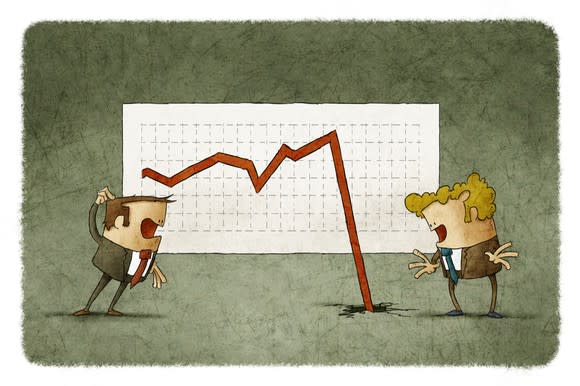Why General Electric Stock Dropped, Then Bounced Back, on Friday
What happened
Friday capped a topsy-turvy week for General Electric (NYSE: GE) stock, as a topsy-turvy last day of the week. After GE reported earnings early in the day, its stock quickly plummeted 6.3% in value -- then rebounded to actually end the day with a small gain of 1.1%. The question is: Why?

I get why GE stock went down. But then how did it go back up? Image source: Getty Images.
So what
Why GE stock dropped early in the day is no great mystery: Earnings were a disaster. Heading into the third-quarter report, analysts were expecting General Electric to report profits of $0.49 per diluted share. In actual fact, all it was able to come up with was $0.29 per share.
It gets worse.
Those weren't even real GAAP profits, but "adjusted" (pro forma) profits. Calculated according to generally accepted accounting principles, GE's per-share profits for Q3 were a mere $0.21 per share, which was down 9% year over year. Even though GE grew its revenues 14% in comparison to last year's Q3, its pre-tax operating profit margins declined by 270 basis points (to 4.4%), negating the benefit of the greater sales, and yielding worse profits.
Now what
General Electric CEO John Flannery called Friday's results "unacceptable, to say the least." Aiming to regain those lost points of profit margin, and more, GE management announced a plan to cut annual operating costs by $1 billion, and sell off about $20 billion worth of underperforming assets over the next year or two. (At the company's current $206 billion market capitalization, this implies that GE will be selling off about 10% of its business units.)
Even so, management cut its forecast for pro forma profits through the end of this year, and now forecasts profits of just $1.05 to $1.10 per share. Cash-from-operations projections took an even bigger hit, with Flannery cutting GE's old, overoptimistic forecast by nearly half, from $13 billion to $7 billion. Topping it all off, Flannery declined to commit to maintaining GE's dividend yield at its current level of 4.1%.
So why did all of the above leave GE stock trading higher at day's end Friday than it closed at before the bad news broke? I guess it's possible investors had thought the news would have been even worse...but I don't really see how that could have been possible.
More From The Motley Fool
Why You're Smart to Buy Shopify Inc. (US) -- Despite Citron's Report
6 Years Later, 6 Charts That Show How Far Apple, Inc. Has Come Since Steve Jobs' Passing
NVIDIA Scores 2 Drone Wins -- Including the AI for an E-Commerce Giant's Delivery Drones
Rich Smith has no position in any of the stocks mentioned. The Motley Fool has no position in any of the stocks mentioned. The Motley Fool has a disclosure policy.

 Yahoo Finance
Yahoo Finance 